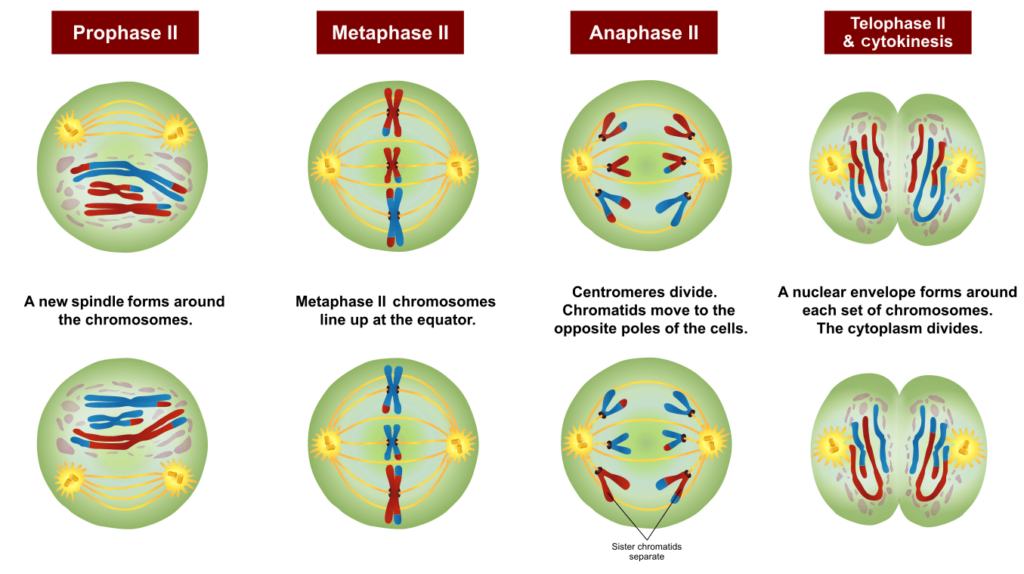Meiosis Phases : Phases of Meiosis 3rd February 2022 – Tags: Meiosis, meiosis I, meiosis II
Many people will have heard of “meiosis phases” or the phases of meiosis, the process of meiosis is essential for all sexually reproducing organisms for the following reasons:
Meiosis maintains a constant number of chromosomes in organisms that reproduce sexually by forming gametes.
By crossing over, meiosis results in the exchange of genes and thus causes genetic variations between species. These variations are the raw material of the evolutionary process.
Meiosis consists of two rounds of cell division, Meiosis I and Meiosis II.
Each round of division contains a period of karyokinesis (nuclear division) and cytokinesis (cytoplasmic division).
What is meiosis?
Meiosis is a process in which a single cell divides twice to produce four cells containing half of the original genetic information. These cells are our sex cells: sperm cells in men and egg cells in women.
Meiosis Phases
Before meiosis, DNA is replicated, as in mitosis. Meiosis then consists of two cell divisions, known as meiosis I and meiosis II. In the first division, which consists of different phases, the duplicated DNA is separated into daughter cells. In the next division, which immediately follows the first, the two alleles of each gene are separated into individual cells.
The two divisions and the different phases or stages of each meiosis are described below. Remember that before meiosis begins, the normally diploid DNA has doubled. This means that there are 4 copies of each gene, present in 2 complete sets of DNA, each set with 2 alleles. In the diagram below, the red chromosomes are the ones inherited from the mother, the blue ones from the father.
At the beginning of the diagram below, the DNA has already replicated, so the red and blue chromosomes look like the letter “X”. Each of these “X” chromosomes is made up of two sister chromatids, i.e. DNA cloned from replication. They are connected at the centromere for storage, but can separate into individual chromosomes.
Meiosis I

In meiosis I, homologous chromosomes separate into two cells so that there is one chromosome (consisting of two chromatids) for each pair of chromosomes in each daughter cell, i.e. two chromosomes in total.
Prophase I
Before prophase, chromosomes replicate to form sister chromatids. Initially there are four chromatids (c) and two chromosomes (n) for each of the 23 chromosome pairs (4c, 2n). The nuclear envelope disintegrates and the chromosomes begin to condense. Spindle fibres appear, which are important for the successful division of chromosomes.
To further increase genetic diversity, homologous chromosomes exchange small parts of themselves, so that one chromosome contains both maternal and paternal DNA. This process is known as crossing over, and the points at which it occurs on a chromosome are called chiasmata.
Prometaphase I
The spindle fibres attach to the chromosomes at points on the chromosomes called centromeres. While this is happening, the chromosomes continue to condense.
Metaphase I
The maternal and paternal versions of the same chromosome (homologous chromosomes) line up along the equator of the cell. A process called “independent assembly” occurs, whereby the maternal and paternal chromosomes randomly line up on either side of the equator. This in turn determines which chromosomes in the gametes are assigned to which chromosomes, resulting in genetic diversity among the offspring.
Anaphase I
Here, each of the homologous chromosomes is pulled towards opposite poles of the cell as the spindle fibres retract. In this way, the DNA is divided equally between the two cells that will be formed.
Telophase I and cytokinesis I
During telophase I, the nuclear envelope reforms and the spindle fibres disappear. In cytokinesis I, the cytoplasm and cell divide, giving rise to two cells that are technically haploid: there is one chromosome and two chromatids per chromosome (2c, n).
Meiosis II

Prophase II and Prometaphase II
These stages are identical to their counterparts in meiosis I.
Metaphase II
In metaphase II, the chromosomes line up in a single row along the equator of the cell. This contrasts with metaphase I, where the chromosomes line up in homologous pairs.
Telophase II
This stage is the same as telophase I.
Cytokinesis II
Again, the cytoplasm and cell divide, producing 2 non-identical haploid daughter cells. As this occurs in the two cells produced by meiosis I, the net product is 4 non-identical haploid daughter cells, each containing a single chromatid chromosome (1c, 1n). These are fully formed gametes.
Applications of meiosis
Meiosis, like mitosis, is used for a number of laboratory technologies, some of which are listed below:
Tissue culture
Like mitosis, meiosis is also used in biotechnology to acquire a gametic condition in cells.
Meiosis often accompanies mitosis to generate variation, which helps in studies relating to evolutionary processes.
In vitro gamete formation
In several infertility problems resulting from gamete failure, embryonic stem cells differentiate into germ-type cells by meiotic division.
These gametes are formed in vitro through meiosis and inserted into individuals with such disorders.
You can read much more about meiosis phases in our blog



